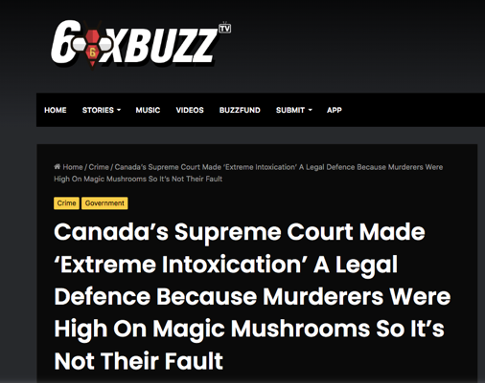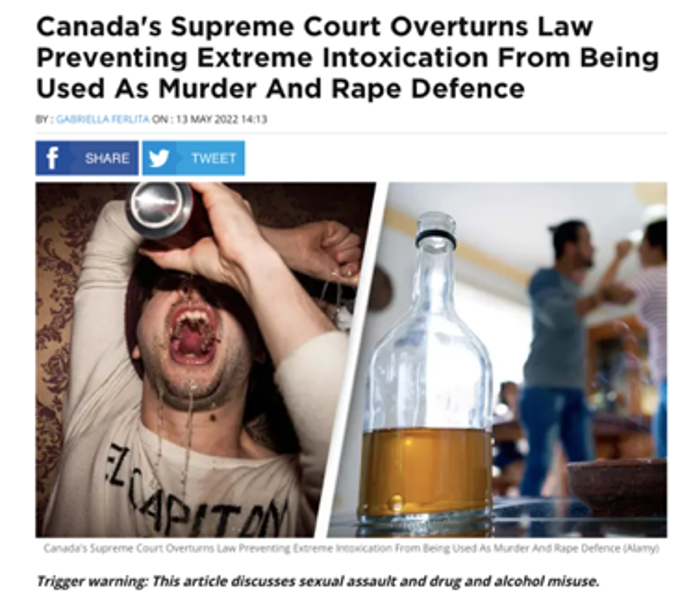“This is not a drunkenness case” is how the Supreme Court of Canada (SCC) opens the second paragraph of the recent R v Brown decision. Despite this explicit instruction, some news media and viral social media posts are intentionally pushing the opposite narrative by insinuating that anyone can get away with a crime if they are intoxicated. For example, 6ixBuzz TV,  a news and entertainment media source with 2.1 million Instagram followers, published a report on Brown and its companion case R v Sullivan entitled “Canada’s Supreme Court Made ‘Extreme Intoxication’ A Legal Defence Because Murderers Were High On Magic Mushrooms So It’s Not Their Fault”. Traditional media has also taken part in minimizing the complexity of the recent decision. Global News released a report that stated, “[the Brown decision] means defendants who voluntarily consume intoxicating substances and then assault or interfere with the bodily integrity of another person can avoid conviction if they can prove they were too intoxicated to control their actions.” While there is some truth to these statements, the real picture is far more complex than these sources are leading their readers to believe, and it is fueling misinformed public outrage.
a news and entertainment media source with 2.1 million Instagram followers, published a report on Brown and its companion case R v Sullivan entitled “Canada’s Supreme Court Made ‘Extreme Intoxication’ A Legal Defence Because Murderers Were High On Magic Mushrooms So It’s Not Their Fault”. Traditional media has also taken part in minimizing the complexity of the recent decision. Global News released a report that stated, “[the Brown decision] means defendants who voluntarily consume intoxicating substances and then assault or interfere with the bodily integrity of another person can avoid conviction if they can prove they were too intoxicated to control their actions.” While there is some truth to these statements, the real picture is far more complex than these sources are leading their readers to believe, and it is fueling misinformed public outrage.
In this blog, I aim to clarify some of the confusion that has arisen in light of the recent Supreme Court decisions, R v Brown and R v Sullivan. I will first explain the defense of Self-induced Extreme Intoxication Automatism (SEIA). Then, I will outline how the recent decisions do not grant a free pass for intoxicated individuals to commit crimes. Lastly, I call upon news media organizations to be more responsible in how they share information and news media consumers to be more responsible in how they engage with and (re)share legal information.
What is Self-induced Extreme Intoxication Automatism?
In a criminal case, a prosecutor must prove beyond a reasonable doubt the guilt of the accused by proving there was mens rea (i.e., intent) and actus reus (i.e., the guilty act). Because an actus reus must be voluntary, a person who does not act voluntarily cannot be found guilty. One notable exception to acting voluntarily is automatism, which is when an individual loses voluntary control over their body. Therefore, in Canada an individual who unconsciously commits a crime may raise automatism. For example, someone who commits a crime while sleepwalking or under hypnosis may be able to raise automatism because, even though they committed a crime, the act was involuntary and therefore cannot be criminally reprehensible.
However, the story does not end there. In some extremely rare cases, a person can be so intoxicated that they enter a state “akin to automatism”. When a person is intoxicated akin to automatism they do not have the voluntariness necessary to commit an offense. Let me be absolutely clear: intoxication akin to automatism is not the same as blacking out during a night out. In Brown, the Supreme Court said that intoxication akin to automatism requires the accused to show that their consciousness was so impaired that it “deprived them of all willed control over their actions” (para 50). It is an almost unconscionable level of intoxication and alcohol use alone is extremely unlikely to successfully support the defense (para 61). It is no surprise that most self-induced intoxication automatism cases involve a person who mixed alcohol and drugs which caused a quasi-psychotic episode (paras 61 and 62).
Self-induced Extreme Intoxication Automatism in Brown and Sullivan
 Contrary to the narrative being pushed on social media, and even some credible news sources, the recent Brown and Sullivan decisions did not create a free pass for criminals if they commit crimes while drunk. The two decisions, released on the same day, concerned accuseds who had committed violent crimes after having consumed drugs. At trial, the judges in all three cases found that each accused were automatons when they committed their violent acts. Because the Supreme Court of Canada is a trier of law and not of facts, it was not its place to re-open whether Brown, Sullivan, or Chan were automatons or not. However, as triers of law, the Supreme Court is responsible for deciding whether a law is constitutional.
Contrary to the narrative being pushed on social media, and even some credible news sources, the recent Brown and Sullivan decisions did not create a free pass for criminals if they commit crimes while drunk. The two decisions, released on the same day, concerned accuseds who had committed violent crimes after having consumed drugs. At trial, the judges in all three cases found that each accused were automatons when they committed their violent acts. Because the Supreme Court of Canada is a trier of law and not of facts, it was not its place to re-open whether Brown, Sullivan, or Chan were automatons or not. However, as triers of law, the Supreme Court is responsible for deciding whether a law is constitutional.
This is where section 33.1 of the Criminal Code of Canada comes in. Section 33.1 prevented an accused who had willing become intoxicated from raising non-mental disorder automatism in cases that interfered with another person’s bodily integrity such as assault or sexual assault. For example, according to section 33.1, an individual who took LSD and entered a psychotic-like state could raise the defense if they stole a bike but could not raise it if they assaulted a cyclist.
However, in Brown the SCC declared section 33.1 unconstitutional. They did so for two reasons. First, the SCC found that section 33.1 breached section 7 of the Charter which protects life, liberty, and security of the person because a person can be found guilty without having the required voluntariness and/or mens rea for criminal liability. This would allow a person who did not voluntarily commit a crime to be convicted and so contravened the principles of fundamental justice. Second, section 33.1 was found to be unconstitutional because it violated section 11 d), the right to be innocent until proven guilty. According to the SCC, section 33.1 substituted the fault and voluntariness of intoxication for the fault and voluntariness of the violent offence. The Court disagreed that the intent to become intoxicated is equivalent to the intent to commit a crime like assault. The court believed that allowing such a substitution would unjustly extend criminal liability to someone who did not foresee an adverse psychotic reaction to something like a prescribed medication.
Not a “Free Pass” for Criminal Activity
 In the end, the two Charter violations were not justified by section 1 of the Charter and so the SCC declared section 33.1 unconstitutional. However, contrary to what some media sources are reporting, the section 33.1 declaration of unconstitutionality did not create a “purge”-like dystopia where anyone can now get drunk and go on an assault spree with impunity. Three reasons demonstrate why the SCC did not open the floodgates to intoxicated crime.
In the end, the two Charter violations were not justified by section 1 of the Charter and so the SCC declared section 33.1 unconstitutional. However, contrary to what some media sources are reporting, the section 33.1 declaration of unconstitutionality did not create a “purge”-like dystopia where anyone can now get drunk and go on an assault spree with impunity. Three reasons demonstrate why the SCC did not open the floodgates to intoxicated crime.
First, a person who drinks to the point of extreme intoxication with the intent to go out and commit a crime will almost certainly fail to raise the non-mental disorder automatism. As mentioned above, alcohol alone is likely insufficient to trigger an automatistic state. If an individual consumes narcotics with the intent to enter an automatistic state in which to commit a crime, and if they successfully complete said crime, then they were probably not in an automatistic state. This is because they had enough control over their body to execute the plan they developed before the self-induced intoxication and so they likely possessed both the actus reus and mens rea to be found guilty of the crime.
Second, regardless of section 33.1, automatism is rarely raised, and it is accepted in even fewer circumstances. This is because the threshold for proving non-mental disorder automatism is incredibly high and requires expert evidence to prove that the individual was an automaton. Before a judge can place the defense before a jury, the judge must be convinced there was an air of reality to the defense. Therefore, both the judge and the jury act as safeguards against an accused inappropriately using that defense. As such, the defense is rarely raised, and it is even rarer that the defense is successful. For example, according to a CanLII search, in 2020, only 10 cases across Canada referenced non-mental disorder automatism. Out of those 10 cases, only two successfully raised the defense: Sullivan and Brown. As such, the rare use—and even rarer success—of this defense demonstrates that it is practically impossible for the Brown decision to open the floodgates to criminals getting off scot-free.
Third, though section 33.1 was found to be of no force and effect, the SCC’s decision does not prevent Parliament from creating new constitutionally compliant legislation that limits how and when an accused may raise non-mental disorder-automatism when it is self-induced through alcohol and narcotics. In fact, in paragraph 11 of the Brown decision, Justice Kasirer points to two ways that Parliament could enact a law to limit the use of non-mental disorder automatism while complying with the accused’s Charter rights. So, even if the Brown decision did open a floodgate—and let’s be clear it did not—it is within Parliament’s power to tightly reseal the gate. In fact, Justice Minister David Lametti already stated that the Canadian government is reviewing the decision and weighing its options carefully.
For these three reasons, the recent Brown and Sullivan decisions did not create a free pass for people to commit crimes while intoxicated, and it is misleading to state otherwise. However, it is understandable that Canadians feel apprehensive about the outcome of these decisions. As the SCC recognized, the use of this rare defense is no comfort for the victims of these cases. Additionally, evidence suggests that the defense is experienced differently depending on gender. According to Sheehy, Grant, and Froc, three professors at different law schools across the country, the defense is disproportionately raised by men and victims in SEIA cases are disproportionately women. Consequently, these decisions raise serious questions that must be part of a well-informed public discussion about gender and the justice system. That discussion will not be fruitful and will not achieve the best result for victims and accuseds if media producers and content creators are misleading readers through attention-grabbing headlines and cherry-picked reporting.
Set the Record Straight: A Call to Be More Responsible when Sharing News Online
 In closing, I call on news media outlets and content creators to be more aware and responsible in how they communicate legal decisions. Specifically, news media organizations should describe the legal precedent and concepts that ground decisions like Brown. Furthermore, when a case involves a Charter analysis, such as in Brown and Sullivan, reporters should explain which Charter rights were at stake, why they are important, and why the Charter infringement was (or was not) justified. Additionally, to avoid cherry-picking media, producers and content creators should avoid focusing on one or two lines of a decision without contextualizing them in the surrounding paragraphs. Lastly, media producers must avoid using inflammatory and misleading language when reporting on legal decisions. Generating more clicks and views is not worth creating a public panic and hindering public trust in our judicial institutions.
In closing, I call on news media outlets and content creators to be more aware and responsible in how they communicate legal decisions. Specifically, news media organizations should describe the legal precedent and concepts that ground decisions like Brown. Furthermore, when a case involves a Charter analysis, such as in Brown and Sullivan, reporters should explain which Charter rights were at stake, why they are important, and why the Charter infringement was (or was not) justified. Additionally, to avoid cherry-picking media, producers and content creators should avoid focusing on one or two lines of a decision without contextualizing them in the surrounding paragraphs. Lastly, media producers must avoid using inflammatory and misleading language when reporting on legal decisions. Generating more clicks and views is not worth creating a public panic and hindering public trust in our judicial institutions.
I also call on media consumers to be responsible in how they consume news media, especially media related to complicated legal decisions. Specifically, I encourage consumers to obtain their information from credible sources. Most large national law firms, law magazines, and law associations publish short, easy-to-read blog posts on recent Supreme Court decisions. These posts are written by legal professionals for a non-legally-trained audience, so they can help readers understand complex legal jurisprudence. Additionally, the SCC now releases “cases in brief” alongside full-length decisions. These short case summaries are specifically written for non-legally trained readers, which can make legal decisions more accessible to everyday Canadians. Together, these sources (i.e., blogs written by legal professionals and SCC summaries) can help news media consumers understand complex legal decisions and may serve as trusted alternatives to sensationalist media sources.
Similarly, social media users should be responsible when (re)sharing information to their accounts from unknown and/or non-credited sources, especially when the information refers to complex legal topics. Content creators sharing legal information may present a misleading narrative as an absolute truth, as was the case in the examples above. When an individual re-shares those slides to their story, they may be inadvertently contributing to the spread of misinformation and stoking distrust in the Canadian judiciary.
In the age of social media, all of us are responsible for the information we share, and we should pay attention to how we can stop the spread of misinformation. This duty falls both on news media producers and news media consumers. To promote an educated and responsible citizenry, it is critical that Canadians are well-informed and can engage in nuanced debates about important issues, such as the Self-induced Extreme Intoxication Automatism defense. As our fellow citizens, we owe it to present and future victims as well as the accuseds to work to understand these problems and reach evidence-based legislative solutions. These goals are only achievable when we base our opinions on facts and accurate information.

